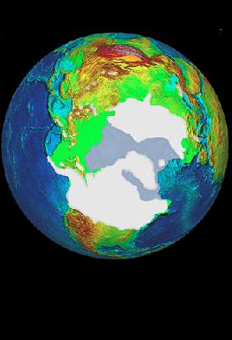NOAA/WDS Paleoclimatology - 700 Year El Niño/Southern Oscillation (ENSO) Niño3.4 Index Reconstruction
This archived Paleoclimatology Study is available from the NOAA National Centers for Environmental Information (NCEI), under the World Data Service (WDS) for Paleoclimatology. The associated NCEI study type is Climate Reconstruction. The data include parameters of climate reconstructions|tree ring with a geographic location of Eastern Pacific Ocean. The time period coverage is from 649 to -55 in calendar years before present (BP). See metadata information for parameter and study location details. Please cite this study when using the data.
Dataset Citation
- Cite as: Li, J.; Xie, S.-P.; Cook, E.R.; Morales, M.S.; Christie, D.A.; Johnson, N.C.; Chen, F.; D'Arrigo, R.D.; Fowler, A.M.; Gou, X.; Fang, K. (2013-07-03): NOAA/WDS Paleoclimatology - 700 Year El Niño/Southern Oscillation (ENSO) Niño3.4 Index Reconstruction. [indicate subset used]. NOAA National Centers for Environmental Information. https://doi.org/10.25921/jfqm-9178. Accessed [date].
- Please refer to Credit tab for full citation information.
Dataset Identifiers
- doi:10.25921/jfqm-9178
- noaa-recon-14632
- NCEI DSI 1200_02
- NCEI DSI 1200_01
ISO 19115-2 Metadata
noaa-recon-14632
| Search Data |
|
| Download Data |
|
| Distribution Formats |
|
| Ordering Instructions | Contact NCEI for other distribution options and instructions. |
| Distributor |
NOAA National Centers for Environmental Information ncei.info@noaa.gov |
| Dataset Point of Contact |
NOAA National Centers for Environmental Information ncei.info@noaa.gov |
| Dataset Point of Contact | Data Center Contact NOAA World Data Service for Paleoclimatology 828-271-4800 paleo@noaa.gov |
| Coverage Description | Date Range: 1301 CE to 2005 CE; Date Range: 649 cal yr BP to -55 cal yr BP; |
| Time Period | 1301 to 2005 |
| Spatial Bounding Box Coordinates |
West: -170
East: -120
South: -5
North: 5
|
| Spatial Coverage Map |
| General Documentation |
|
| Associated Resources |
|
| Publication Dates |
|
| Data Presentation Form | Digital table - digital representation of facts or figures systematically displayed, especially in columns |
| Dataset Progress Status | Complete - production of the data has been completed |
| Data Update Frequency | Data update frequency not available |
| Supplemental Information | STUDY NOTES: An index of canonical El Niño/Southern Oscillation (ENSO) variability for the past seven centuries, derived from 2,222 tree-ring chronologies from Asia, New Zealand, and North and South America. The reconstruction targets the prior winter (November-January, NDJ) Niño3.4 index, and covers 1301-2005. SST anomalies (SSTAs) are relative to the mean of observed SSTs during 1971-2000. ABSTRACT SUPPLIED BY ORIGINATOR: Predicting how the El Niño/Southern Oscillation (ENSO) will change with global warming is of enormous importance to society. ENSO exhibits considerable natural variability at interdecadal-centennial timescales. Instrumental records are too short to determine whether ENSO has changed and existing reconstructions are often developed without adequate tropical records. Here we present a seven-century-long ENSO reconstruction based on 2,222 tree-ring chronologies from both the tropics and mid-latitudes in both hemispheres. The inclusion of tropical records enables us to achieve unprecedented accuracy, as attested by high correlations with equatorial Pacific corals and coherent modulation of global teleconnections that are consistent with an independent Northern Hemisphere temperature reconstruction. Our data indicate that ENSO activity in the late twentieth century was anomalously high over the past seven centuries, suggestive of a response to continuing global warming. Climate models disagree on the ENSO response to global warming, suggesting that many models underestimate the sensitivity to radiative perturbations. Illustrating the radiative effect, our reconstruction reveals a robust ENSO response to large tropical eruptions, with anomalous cooling in the east-central tropical Pacific in the year of eruption, followed by anomalous warming one year after. Our observations provide crucial constraints for improving climate models and their future projections. |
| Purpose | Records of past temperature, precipitation, and other climate variables derived from paleoclimate proxies. Parameter keywords describe what was measured in this data set. Additional summary information can be found in the abstracts of papers listed in the data set citations. |
| Dataset Citation |
|
| Cited Authors |
|
| Originators |
|
| Publishers |
|
| Theme keywords |
Global Change Master Directory (GCMD) Science Keywords
|
| Data Center keywords |
Global Change Master Directory (GCMD) Data Center Keywords
|
| Place keywords |
|
| Use Constraints |
|
| Access Constraints |
|
| Fees |
|
Last Modified: 2024-12-06
For questions about the information on this page, please email: ncei.info@noaa.gov
For questions about the information on this page, please email: ncei.info@noaa.gov

